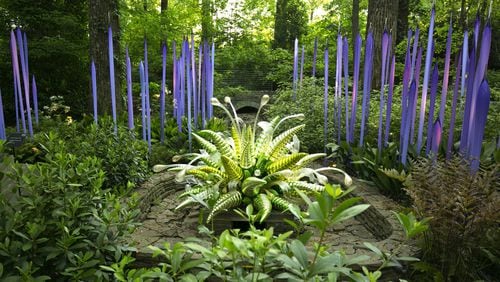ART REVIEW
“Chihuly in the Garden”
Through Oct. 30. 9 a.m.-7 p.m. Tuesdays; 9 a.m.-5 p.m. Wednesdays-Sundays. $21.95 adult (members free), $15.95 ages 3-12 (members free), children under 3 free. Night admission: 6-10 p.m. Wednesdays-Sundays (last ticket sold at 10 p.m., garden remains opens until 11 p.m.). $21.95 adult (members $15.95), $15.95 ages 3-12 (members $9.95), children under 3 free. Atlanta Botanical Garden, 1345 Piedmont Ave. N.E., Atlanta. 404-876-5859, www.atlantabg.org/visit/events/chihuly.
Bottom line: A crowd-pleasing glass artist returns to the Atlanta Botanical Garden with some great and some mediocre work in the mix.
He's baaaaaack. After helping the Atlanta Botanical Garden attract a record-breaking 375,000 visitors and launch its fledgling series of art exhibitions in the garden in 2004, Seattle-based glass artist Dale Chihuly has returned to the garden with 20 pieces placed throughout the shrubs, manicured lawns, woodlands and meadows of this glorious human-devised celebration of the natural world.
The temptation to bring Chihuly back must have been extraordinary: The garden has increased not just its acreage, from 15 to 30 acres as part of a garden expansion since that first Chihuly show, but also its presence in the city, with an edible garden that taps into the city's chef-driven economy, the new Linton's restaurant helmed by James Beard Award-winning Atlanta chef Linton Hopkins and a redesign that better connects to Piedmont Park and the city as a whole. In celebration of its 40th anniversary, inviting this crowd-pleaser for an encore makes a certain kind of strategic sense, though I will admit to disappointment at the garden revisiting old territory, a sensation akin to news of Hollywood riding the coattails of a blockbuster with a bankable sequel.
While subsequent exhibitions after that first Chihuly windfall may not have been as popular, the garden did an admirable job of bringing a unique roster of unexpected artists to the space: Henry Moore, Niki de Saint Phalle, Philip Haas and Bruce Munro among others, offering dramatically different experiences depending upon the artist chosen. Hopefully, the garden will continue that tendency to surprise and delight.
There are some certifiable showstoppers in "Chihuly in the Garden" this go-round. A particularly inspired choice was installing a series of bobbing glass orbs, patterned like Murano glass marbles or fishing lures, in the small pond in the Cascades Garden flanked by the Mosaiculture "Earth Goddess." There is a lovely synergy between that plant lady created for another memorable garden exhibition and the bright curlicue forms fashioned into a boat that floats on the water's surface in "Fiori Boat and Niijima Floats" (2016).
Water is a wonderful handmaiden for Chihuly, and some of the best pieces take advantage of its reflective, kinetic qualities. The most successful works also milk drama from the garden’s unique vistas that operate as a kind of showcase for monumental work. Chihuly’s 27 1/2-foot “Saffron Tower” (2008) in Storza Woods, poised like sunshine transmogrified into an electrified column, sits at the end of the garden’s Water Mirror looking like a pagan Washington Monument.
There is a natural symbiosis, of course, between an art form that originates in the organic and this natural setting. Chihuly’s reed forms and flowers mimic and pay tribute to the often-overlooked magnificence of the natural world. Chihuly’s work in botanical gardens arrests our attention, serving as a kind of exclamation point and neon sign to highlight what is right under our noses.
But there is also plenty of lackluster work in “Chihuly in the Garden” that can make some of this show feel like a phone-in. On the list of uninspiring pieces are the strange, milky white polyp forms “White Belugas” that sit awkwardly in a verdant garden nook. In the Fuqua Conservatory, “Sapphire Neon With Neodymium Reeds, Floats, and Logs” (2015) is anything but subtle, and far from pieces that work in concert with nature. Neon purples and blues and black and white orbs make the piece feel like a New Wave-era record shop or dance club window display. In such cases, nature upstages Chihuly and proves that the man-made can’t always compete.
But will such weaker pieces impact attendance for “Chihuly in the Garden” or dampen his fans’ enthusiasm? Probably not. The artist seems virtually bulletproof at this stage in his career.






